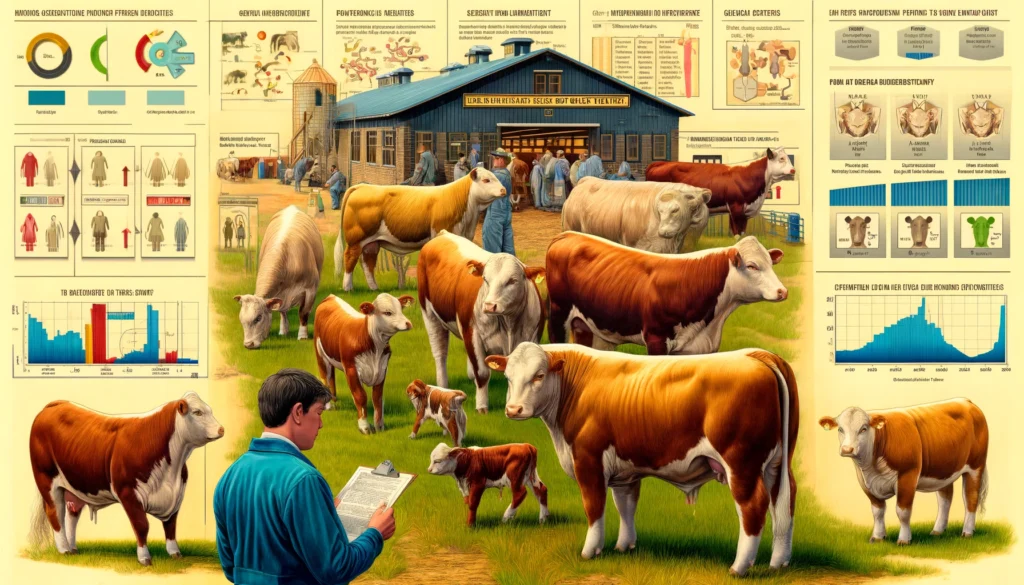
Embryo Transfer A detailed and informative illustration depicting the concept of genetic traits in cattle. The scene includes a variety of cows with different physica 2.webp.webp
Definition: Embryo Transfer
Overview
Embryo transfer (ET) in farm animals is a reproductive technology that involves collecting fertilized embryos from a donor female and transferring them to recipient females. This technique allows for the rapid multiplication of desirable genetic traits from high-quality animals, improving the overall genetic quality and productivity of the herd or flock. ET is commonly used in cattle, sheep, goats, and other livestock species.
Benefits of Embryo Transfer
Genetic Improvement
Embryo transfer allows for the rapid dissemination of superior genetic traits. By using embryos from high-quality donor females, farmers can enhance the genetic potential of their herds or flocks, resulting in healthier, more productive animals.
Fall off the barn roof and busted your keister? Life on the farm or ranch can be tough on the bum. Need a break? Laugh it off at FarmerCowboy.com, the #1 farm humor site. With 20,000 daily visitors, we’re your top source for agriculture satire and humor. Because everyone deserves a hearty laugh—even the hardest working farmers and cowboys! Join us and turn those long days into fun tales at FarmerCowboy.com.
Increased Reproductive Efficiency
ET enables the production of multiple offspring from a single donor female in one breeding season. This increases the reproductive output and efficiency, allowing farmers to achieve their breeding goals more quickly and effectively.
Disease Control
Since ET involves transferring embryos rather than live animals, it reduces the risk of transmitting diseases. This contributes to maintaining the health and biosecurity of the herd or flock.
Components of Embryo Transfer
Donor Selection
Selecting high-quality donor females is crucial for successful ET. Donors should exhibit superior genetic traits, good reproductive health, and a history of high fertility. Veterinary examinations and genetic evaluations are often conducted to identify suitable donors.
Superovulation
Superovulation involves administering hormone treatments to the donor female to stimulate the production of multiple eggs. This process increases the number of embryos available for collection and transfer.
Embryo Collection
Embryo collection, also known as flushing, is performed a few days after insemination. The embryos are collected from the donor’s uterus using a non-surgical or surgical method, depending on the species and circumstances.
Embryo Evaluation and Storage
Collected embryos are evaluated for quality and viability under a microscope. High-quality embryos are then either transferred immediately to recipient females or frozen for future use. Freezing allows for flexible scheduling and long-term storage of valuable genetics.
Embryo Transfer Procedure
The embryo transfer procedure involves thawing (if necessary) and implanting the embryos into the reproductive tract of recipient females. Recipient females are typically synchronized with the donor’s cycle to ensure optimal conditions for embryo implantation and development.
Techniques in Embryo Transfer
In Vitro Fertilization (IVF)
In vitro fertilization (IVF) is an advanced technique often used in conjunction with ET. It involves fertilizing eggs outside the body and then transferring the resulting embryos to recipient females. IVF can enhance the efficiency and success rates of ET programs.
Genetic Screening
Genetic screening of embryos allows for the selection of those with desirable traits before transfer. Techniques such as preimplantation genetic diagnosis (PGD) help identify embryos with specific genetic markers, improving the precision of breeding programs.
Cryopreservation
Cryopreservation, or freezing, of embryos enables long-term storage and transportation of genetic material. This technology allows farmers to access superior genetics from distant locations and plan breeding programs with greater flexibility.
Best Practices for Embryo Transfer
Training and Expertise
Successful ET requires skilled personnel and proper training. Veterinarians and technicians involved in ET programs should be proficient in handling, evaluating, and transferring embryos to ensure high success rates.
Health and Nutrition
Maintaining the health and nutrition of both donor and recipient females is essential for successful ET. Proper nutrition, regular veterinary care, and stress management contribute to better reproductive outcomes and embryo viability.
Record Keeping
Detailed records of donor and recipient animals, hormone treatments, embryo quality, and transfer outcomes are crucial for managing ET programs. Accurate record-keeping helps track progress, identify trends, and make informed decisions for future breeding cycles.
Economic Considerations
Cost of ET Services
The cost of ET services can vary based on factors such as the type of animals, the complexity of the procedures, and the expertise required. While ET can be an expensive technology, the long-term benefits of genetic improvement and increased productivity often justify the investment.
Return on Investment
Conducting a cost-benefit analysis helps farmers assess the return on investment for ET programs. This analysis should consider factors such as enhanced genetic traits, increased reproductive efficiency, and higher production rates.
Environmental Impact
Sustainable Breeding Practices
ET contributes to sustainable breeding practices by maximizing the genetic potential of high-quality animals. This leads to more efficient use of resources and reduced environmental impact, as fewer animals are needed to achieve the same level of production.
Conservation of Genetic Diversity
ET can be used to preserve and propagate the genetics of rare or endangered livestock breeds. By multiplying the offspring of genetically valuable animals, farmers can contribute to the conservation of biodiversity within agricultural systems.
Case Studies
Case Study 1: Genetic Advancement in Dairy Cattle
A dairy farm in California implemented an ET program to enhance milk production and herd health. By using embryos from high-genetic-merit donor cows, the farm achieved significant improvements in milk yield, udder health, and overall herd productivity.
Case Study 2: Rapid Expansion of Sheep Flock
A sheep farmer in Australia used ET to rapidly expand and improve the genetic quality of their flock. The program resulted in a higher number of lambs per breeding season and better growth rates, leading to increased profitability and market competitiveness.
Conclusion
Embryo transfer is a powerful reproductive technology that offers numerous benefits for livestock breeding. By enabling the rapid multiplication of desirable genetic traits and improving reproductive efficiency, ET contributes to the overall productivity and profitability of farming operations. Understanding the components, techniques, and best practices of ET allows farmers to make informed decisions and maximize the potential of their breeding programs. With ongoing advancements in ET technology, the future of livestock breeding holds great promise for enhanced genetic quality and sustainable agricultural practices.

Originally posted 2012-10-08 13:45:12.
Originally posted 2024-06-26 16:46:20.
Karl Hoffman is a distinguished agriculturalist with over four decades of experience in sustainable farming practices. He holds a Ph.D. in Agronomy from Cornell University and has made significant contributions as a professor at Iowa State University. Hoffman’s groundbreaking research on integrated pest management and soil health has revolutionized modern agriculture. As a respected farm journalist, his column “Field Notes with Karl Hoffman” and his blog “The Modern Farmer” provide insightful, practical advice to a global audience. Hoffman’s work with the USDA and the United Nations FAO has enhanced food security worldwide. His awards include the USDA’s Distinguished Service Award and the World Food Prize, reflecting his profound impact on agriculture and sustainability.






